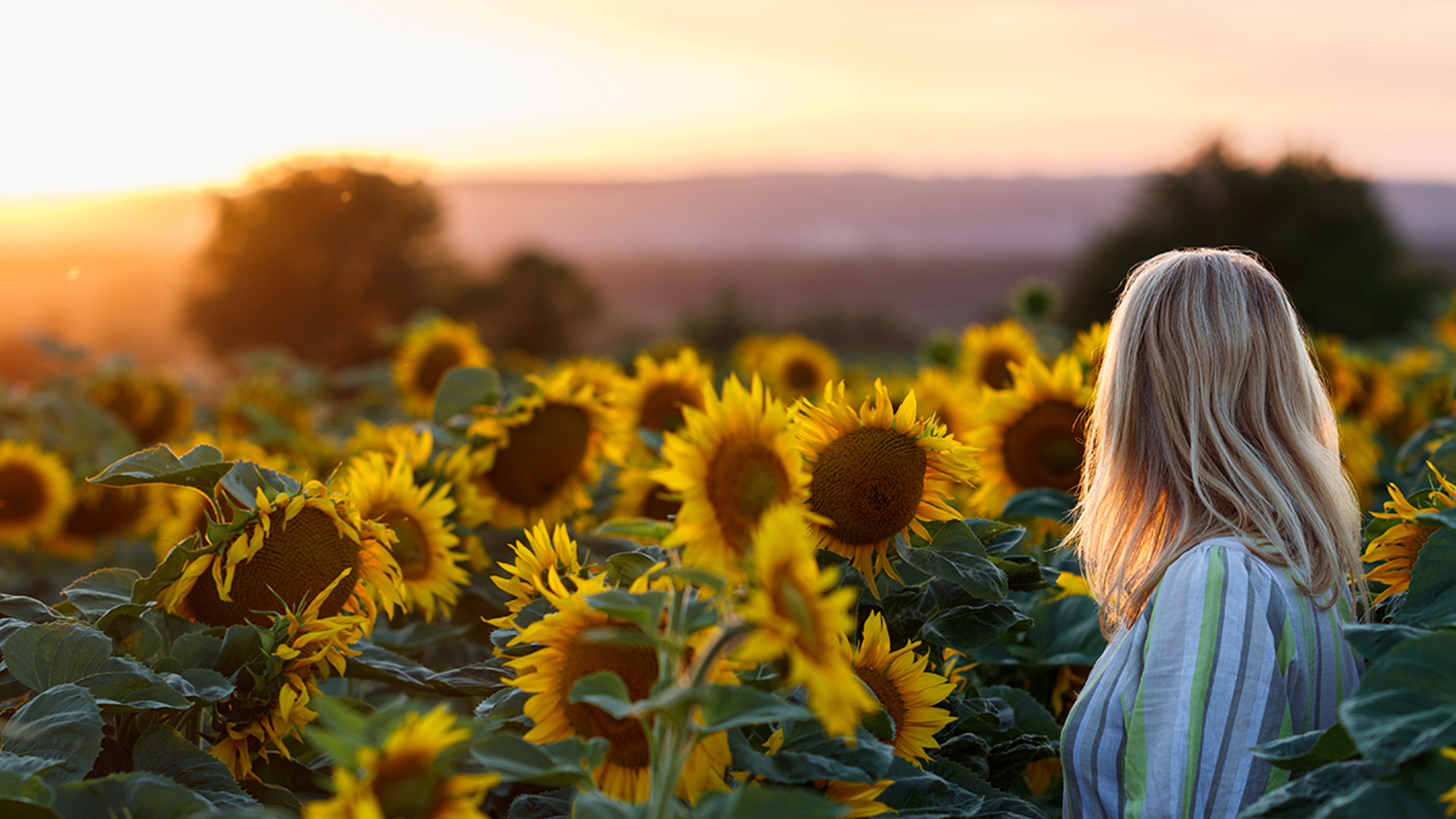Sunflower Facts: 11 Things You Didn't Know About This Iconic Bloom
Known for their height, beauty, and ability to bring a smile to people's faces, these flowers also have a fascinating history.
Aug 17, 2022
The sunflower is one of the most interesting and unique flowers on earth, one that has delighted and inspired humans for millennia. A cousin of the daisy, the sunflower is a member of the Aster (Asteraceae), or Composite (Compositae), plant family, a group of more than 32,000 formally recognized species with more than 1,900 genera, or types.
The common sunflower is most often recognized by its large head, fuzzy stalk, vibrant yellow petals, and large, round dark center; however, there are more than 70 varieties that come in all colors, shapes, and sizes. The American Giant, for example, can grow as high as 14 to 16 feet tall, whereas the cute, pouf-like Teddy Bear Dwarf maxes out at 3 feet in height. The plant's color palettes include myriad shades of red, purple, orange, and brown. Additionally, a single sunflower can produce up to 2,000 seeds — talk about an extended family!

Dig deeper into this remarkable flower with these 11 sunflower facts.
1. World travelers
The sunflower was originally discovered, and subsequently grown, around 4500 B.C. by indigenous tribes in North America. It was used for food and medicinal purposes by its cultivators, who extracted its seeds and petals to make flour and meal, oil, paint, and dye, and to treat maladies including chest paints, rheumatism, and sunstroke. They also used the stalks as a building material.
When European explorers arrived in the New World in the 1500s, they were so captivated by the sunflower that they harvested thousands of its seeds and exported them back to their home continent. Rather than use the flowers for practical purposes, however, the Europeans of that time employed sunflowers primarily for decorative and ornamental means.
The sunflower grew in popularity and demand over the next 300 years continued to make its way across Europe and into Russia. By the early 19th century, the benefits of sunflower oil became more widely recognized, particularly in Russia, where nearly 2 million acres of farmland were dedicated to growing sunflowers for seed extraction.
2. Coming full circle
By the late 1800s, Russian immigrants began arriving en masse on North American shores, bringing with them a new, larger variety of sunflower from their homeland. Dubbed the “Mammoth Russian," this colossal flower — rich in protein and nutrients — became a staple with U.S. farmers. The hardy stalks were burned for fuel, while the seeds were ground and mixed into animal feed. This renewed demand for sunflowers increased cultivation in the U.S., and by the 1920s, the flower had become a commodity.

3. The Sunflower State
During the North American sunflower boon, the flower grew wildly and abundantly in Kansas. While most appreciated its beauty and utility, the state legislature passed a law in 1895 declaring the sunflower a “noxious weed" to be eliminated. Nevertheless, its popularity persisted, and in 1903, Senator George P. Morehouse drafted a bill designating the sunflower the state's official bloom. The bill was signed into law March 12, 1903, and Kansas thereafter became known as the Sunflower State.
4. What's in a name?
Officially known as the helianthus annuus, the sunflower derived its name from the Greek root words helia, meaning “sun," and anthos, meaning “flower." While it may boast sun-like characteristics in its appearance, the sunflower was not actually named for the sun. Sunflowers are heliotropic, meaning they track with the movement of the sun from east to west before returning to an eastward-facing position after sunset. This phenomenon occurs only in young buds. Once the plant has flowered and is plentiful in seeds, it assumes a fixed position facing east.

5. A sum of its parts
At first glance, this cheerful golden-hued bloom appears to consist of hundreds of silky petals surrounding a dense, coarse center. But the sunflower is, in fact, made up of thousands of tiny individual flowers. That dark center consists of disk florets: little flowers, each consisting of five tiny dark petals folded into an oblong-shaped tube. Its colorful “petals," meanwhile, aren't really petals at all. They are known as ray florets: more tiny flowers that compose the vibrant outer ring.
6. Good day, sunshine
As heliotropic flowers that call to mind the sun, sunflowers signify loyalty, devotion, and admiration, as well as warmth and happiness. In some Asian cultures, sunflowers also are believed to bring good fortune and foster healing.
7. Reverence and respect
The sunflower was a significant symbol in ancient Aztec and Inca culture. It has been said that both civilizations worshipped sunflowers as sun gods; moreover, images of sunflowers were depicted on the shields of warriors, a sign that the flower was also a sign of war and military might.
8. Family drama
The sunflower has ties to Greek mythology, in the story of Apollo, god of the sun, and Clytie, his love. In this myth, Apollo is captivated by the beauty of Clytie's sister, Leucothoe, but the sisters' father, the king, forbids the union. When Clytie learns of a secret meeting between Apollo and Leucothoe, she succumbs to a fit of jealousy and reveals the rendezvous to the king. Outraged, the king has Leucothoe buried alive. A heartbroken Apollo refuses to forgive Clytie, who subsequently starts to wither in grief. In an act of final revenge for her cruelty, Apollo turns Clytie into a sunflower.
9. Art of the sunflower
Known as the “painter of sunflowers," post-impressionist artist Vincent van Gogh selected this subject as his muse at a time when his contemporaries were painting more traditional floral still lifes in less vibrant palettes. He completed dozens of sunflower paintings and was thrilled to discover that his friend, mentor, and fellow artist, Paul Gauguin, also admired them greatly. Upon learning of Gauguin's intent to visit his artist colony, van Gogh painted several more sunflower still lifes and hung them in Gauguin's guest room. When Gauguin saw the paintings, he remarked that they were “completely Vincent."
10. Good things happen in threes
Sunflowers are the traditional celebratory flower of the third wedding anniversary. The sunflower head relies on its sturdy stalk to provide a supportive foundation for growth —a metaphor that represents the strong bonds of marriage.
11. World's tallest sunflower
No article about sunflowers would be complete without revealing the world record holder for the tallest specimen on earth! That distinction goes to Hans-Peter Schiffer of Karst, Germany, who, in August 2014, needed to call in the support of the local fire department to scaffold his plant so that its height could be accurately recorded. The result was a whopping 30 feet, 1 inch. Schiffer also holds the three previous world records for tallest sunflower, those coming in 2009 (26 feet, 4 inches), 2012 (27 feet), and 2013 (28 feet, 8 inches). Talk about a green thumb!










